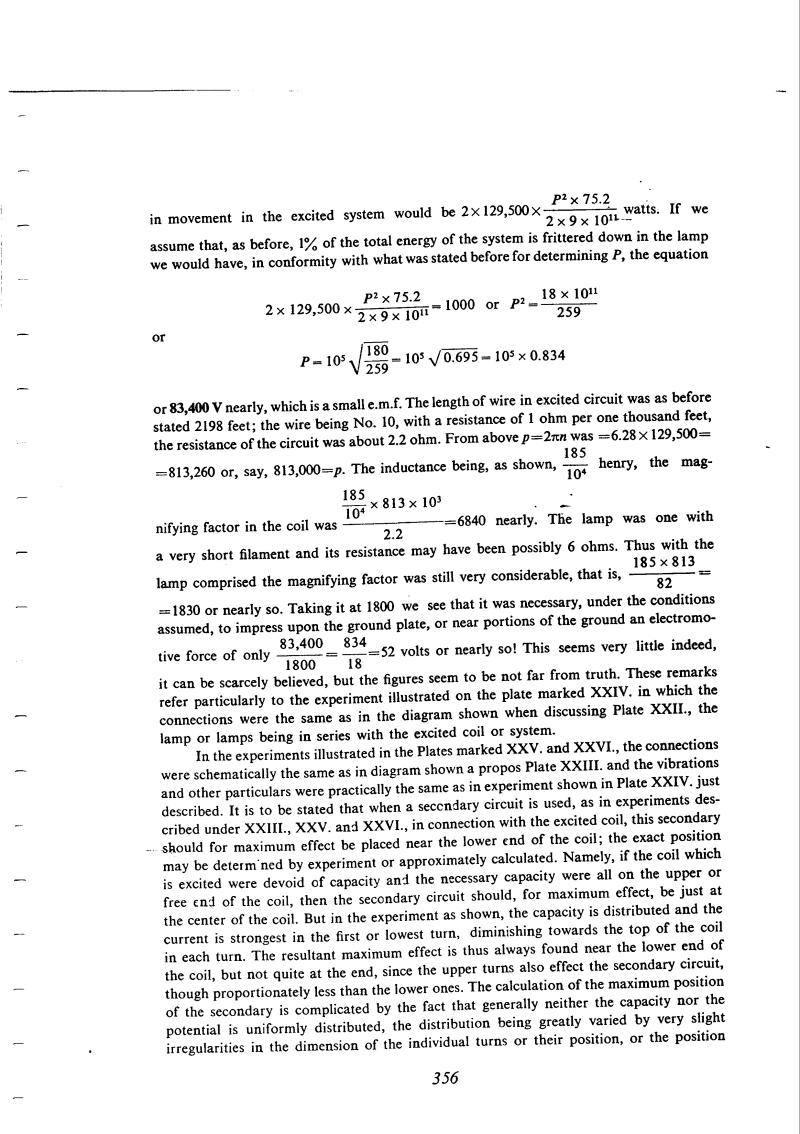
Nikola Tesla Books
in movement in the excited system would be 2 x 129,500 x $! {{P^{2} \times 75.2} \over {2 \times 9 \times 10^{11}}} $! watts.
If we assume that, as before, 1% of the total energy of the system is frittered down in the lamp we would have, in conformity with what was stated before for determining P, the equation
$! {2 \times 129,500 \times {{P^{2} \times 75.2} \over {2 \times 9 \times 10^{11}}}} $! = 1000 or P2 = $! {{18 \times 10^{11}} \over 259} $!
or
P = $! {10^{5} \sqrt{180 \over 259}} $! = $! {10^{5} \sqrt{0.695}} $! = $! {10^{5} \times 0.834} $!
or 83,400 V nearly, which is a small e.m.f. The length of wire in excited circuit was as before stated 2198 feet; the wire being No. 10, with a resistance of 1 ohm per one thousand feet, the resistance of the circuit was about 2.2 ohm. From above p = 2Ïn was = 6.28 x 129,500 = 813,260 or, say, 813,000 = p. The inductance being, as shown, $! {185 \over 10^{4}} $! henry, the magnifying factor in the coil was $! {{{185 \over 10^{4}} \times 813 \times 10^{3}} \over 2.2} $! = 6840 nearly. The lamp was one with a very short filament and its resistance may have been possibly 6 ohms. Thus with the lamp comprised the magnifying factor was still very considerable, that is, $! {{185 \times 813} \over 82} $! = 1830 or nearly so. Taking it at 1800 we see that it was necessary, under the conditions assumed, to impress upon the ground plate, or near portions of the ground an electromotive force of only $! {83,400 \over 1800} $! = $! {834 \over 18} $! = 52 volts or nearly so! This seems very little indeed, it can be scarcely believed, but the figures seem to be not far from truth. These remarks refer particularly to the experiment illustrated on the plate marked XXIV. in which the connections were the same as in the diagram shown when discussing Plate XXII., the lamp or lamps being in series with the excited coil or system.
The explanation to Photograph XXII concerning the transmission of power from the excited primary circuit to the âextra coilâ via the earth is similar to that he gave in 1893(6). The experiment to which the photograph refers was made with the aim of estimating the power of the oscillator from the thermal effect of the HF current. What Tesla calls the âtotal energy set in movementâ would correspond to the total energy transferred to condenser in the secondary (i.e. the power) if an energy of $!{1 \over 2}$! CV2 is transferred in each half-cycle. It can be shown that the active power dissipated in the circuit is much less than this and is inversely proportional to the Q-factor of the oscillating circuit.
January 2
Tesla gave his observations on 22 pages. On them he described eleven photographs. The explanation along with photograph No. 22 about energy transmission from excitation of the primary circuit to "additional coil" over the earth surface is similar to the one from 1893(6). Otherwise the experiment to which the photograph is related was performed for the purpose of oscillator power estimate on the basis of thermal effects of high frequency current.
That which Tesla calls "total energy placed in motion" would correspond to the total energy which is supplied to a capacitor per second (i.e. power) if energy ½CV2 is supplied during the duration of one half of the period.
It could be shown that the active power which is spent in the circuit is considerably smaller than this power, and opposite, proportionally to the quality factor of the oscillating circuit. On several following photographs, the movable resonant coil with connected bulbs is photographed which is supplied by transmitted high frequency energy. One terminal of this coil is connected to the ground, and the other is open ended or a short piece of wire is connected to it. Bulbs are coupled by means of the auxiliary secondary coil inductively with the secondary coil. The data was not given on the distance of resonant coil from the oscillator coil. Tesla's comment on photograph No. 27 illustrates the interest on the question of electrical lightning, though he worked on this for more than ten years. One earlier discovery on gas elimination and not only filament, when working with high frequency currents is again proven(5).
On photograph No. 28 the bulb is connected in series with a terminal capacitance load. In the calculations "total energy placed in movement" is not taken when it was assumed that the electrostatic energy ½CV2 is spent in the bulb during one half of the period. A similar comment is valid for photograph No. 29.
Tesla mentioned several times that the main transmission from the exciting to the excited circuit is done via the ground. The proof for this statement he found in the experiment illustrated by photograph No. 30. He concluded that the induced voltage in the excited circuit is significantly reduced when the ground connection is disconnected. Photograph No. 31 is an X-ray photograph of a finger. The comments on this experiment are an illustration of Tesla's interest in the radiation field which was mentioned earlier (please see comment on June 6, 1899).

